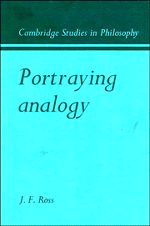Book contents
- Frontmatter
- Contents
- Dedication
- Preface
- Introduction
- 1 The limitations of classical analogy theory and the Miller's Analogies transition
- 2 The genus: meaning differentiation
- 3 Predicate schemes: an explanatory model
- 4 Equivocation, analogy and metaphor
- 5 Denominative analogy and paronymy
- 6 Figurative discourse
- 7 Analogy and religious discourse: craftbound discourse
- 8 Analogy and analysis
- Notes
- Bibliography
- Name index
- Subject index
5 - Denominative analogy and paronymy
Published online by Cambridge University Press: 07 October 2011
- Frontmatter
- Contents
- Dedication
- Preface
- Introduction
- 1 The limitations of classical analogy theory and the Miller's Analogies transition
- 2 The genus: meaning differentiation
- 3 Predicate schemes: an explanatory model
- 4 Equivocation, analogy and metaphor
- 5 Denominative analogy and paronymy
- 6 Figurative discourse
- 7 Analogy and religious discourse: craftbound discourse
- 8 Analogy and analysis
- Notes
- Bibliography
- Name index
- Subject index
Summary
There is another kind of analogy, denominative analogy, that results from contrasts of predicate mode. It consists of differentiated denominations (relational naming: to plow/a plow; to smoke/smokes), of which there are several kinds.
Denominative analogy is particularly important in accounting (a) for the relatedness among paronyms, (b) for figurative discourse (metonymy, synecdoche, antonomasia), (c) for the transfer of thing-names and event-names into verbs, and vice versa, and (d) for the relatedness of the same words used contrastively to impute activity, proclivity, tendency, disposition, and the like. For example, ‘He cheated’ (once) as against ‘He cheated’ (characteristically); ‘He is a responsible young man’; ‘His was a responsible action under conditions of great uncertainty’.
Denominative analogy sometimes involves abstractive analogy of proportionality (cf. chapter 4) along with contrasting predicate modes: ‘Most of the employees at Newtown are healthy; Newtown, as the travel agents all say, is a healthy place.’ The second ‘healthy’ is both denominatively and abstractively differentiated from the first. And there can be metaphorically denominative pairs, too, that is the basis of personification (see chapter 6).
What Cajetan (1498: ch.2, sec. 10–15) called ‘analogy of attribution’ and Aquinas (De Veritate, 21, 4 ad 4 and Principles of Nature, ch.6, no. 38) ‘analogy because of diverse attributions’, is a species of denominative analogy. For example, the analogy of meaning between ‘healthy’, applied to the intrinsic state of a dog, and ‘healthy’, applied to the appearance of its coat.
- Type
- Chapter
- Information
- Portraying Analogy , pp. 121 - 141Publisher: Cambridge University PressPrint publication year: 1982



